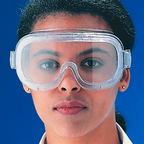
 Splash goggles are necessary for any task which could result in
liquid splashes to the eye that might not be prevented by safety glasses (even with side
shields). The hazard assessment and standard operating procedure relevant to the
work at hand will prescribe chemical splash goggles vs. safety glasses (with or without
side shields) depending usually on the volume of liquid in use and the hazards.
A good rule is to define the "splash zone" as
anywhere within ten feet (unshielded) of any handling or reaction involving
50 mL of any harmful liquid (corrosive, organic, toxic...), and make the
rule that anyone in the splash zone must be wearing splash goggles. Splash goggles are necessary for any task which could result in
liquid splashes to the eye that might not be prevented by safety glasses (even with side
shields). The hazard assessment and standard operating procedure relevant to the
work at hand will prescribe chemical splash goggles vs. safety glasses (with or without
side shields) depending usually on the volume of liquid in use and the hazards.
A good rule is to define the "splash zone" as
anywhere within ten feet (unshielded) of any handling or reaction involving
50 mL of any harmful liquid (corrosive, organic, toxic...), and make the
rule that anyone in the splash zone must be wearing splash goggles.
 ANSI
approved chemical splash goggles. Worn properly.
Splash goggles are not directly vented, sometimes not vented at all.
"Worn correctly" means no gaps that liquid could enter. When worn
properly, splash goggles will protect the eyes and surrounding skin from
forcefully propelled liquids coming from any direction above, below, beside,
or behind to wearer. ANSI
approved chemical splash goggles. Worn properly.
Splash goggles are not directly vented, sometimes not vented at all.
"Worn correctly" means no gaps that liquid could enter. When worn
properly, splash goggles will protect the eyes and surrounding skin from
forcefully propelled liquids coming from any direction above, below, beside,
or behind to wearer.
 goggles
are properly worn when they are comfortably situated on head/face in a position that
prevents the possibility of any splashed liquid reaching either eye from any location (a
big splash from the side, or liquid dribbling or gushing down from the top of your
head...) Visually inspect all eye protection for damage before use and after
removal. If there is an elastic band it should be springy and firm, or it should be
replaced before the eyewear is used. Do not use eyewear with cracks or weaknesses.
If the goggles have breathervent-covers that can be turned inside out, do not
use the goggles with the vent-covers turned inside out. This increases ventilation
but completely destroys the indirect (baffled) air path which makes them splash
goggles. goggles
are properly worn when they are comfortably situated on head/face in a position that
prevents the possibility of any splashed liquid reaching either eye from any location (a
big splash from the side, or liquid dribbling or gushing down from the top of your
head...) Visually inspect all eye protection for damage before use and after
removal. If there is an elastic band it should be springy and firm, or it should be
replaced before the eyewear is used. Do not use eyewear with cracks or weaknesses.
If the goggles have breathervent-covers that can be turned inside out, do not
use the goggles with the vent-covers turned inside out. This increases ventilation
but completely destroys the indirect (baffled) air path which makes them splash
goggles.
 Goggles will not protect against "explosions" of liquids.
("Explosion" of liquid should be taken to mean any eruption or violent
splash of a quantity of liquid having enough force to penetrate the face/goggle interface
or the breather vents. A full face shield is the minimum requirement for work
presenting the possibility of such violence.
Goggles will not protect against "explosions" of liquids.
("Explosion" of liquid should be taken to mean any eruption or violent
splash of a quantity of liquid having enough force to penetrate the face/goggle interface
or the breather vents. A full face shield is the minimum requirement for work
presenting the possibility of such violence.
 Clean goggles
regularly with mild soap and water, dry, and store in a dry, temperate storage area.
Hanging them up by the elastic band will cause unnecessary wear on the band.
Goggles well cared for will last for years. There are no special disposal
considerations for them if they are not contaminated with chemical or biological waste;
they are regular trash. Clean goggles
regularly with mild soap and water, dry, and store in a dry, temperate storage area.
Hanging them up by the elastic band will cause unnecessary wear on the band.
Goggles well cared for will last for years. There are no special disposal
considerations for them if they are not contaminated with chemical or biological waste;
they are regular trash. |

